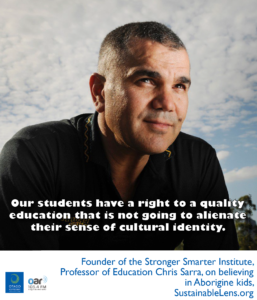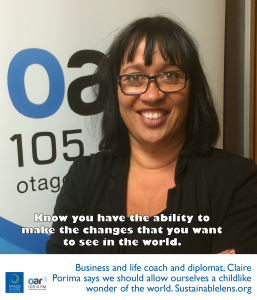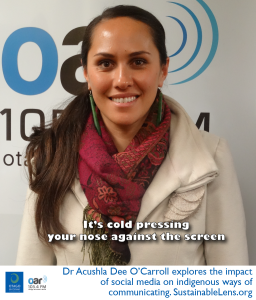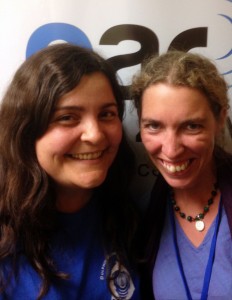
This is social justice, it’s clearly a human rights issue, our students have a right to a quality education that is not going to alienate their sense of cultural identity.
Professor Chris Sarra is the founder of the Stronger Smarter Institute. He is Professor of Education at University of Canberra.
Chris became the first Aboriginal principal of Cherbourg State School where he made significant changes to the way that Indigenous students experienced education. Chris challenged the whole school community to have high expectations of Indigenous students and fostered the ‘strong and smart’ approach which embraced a strong and positive sense of what it means to be Aboriginal in contemporary Australian society. This success led to the formation of the Stronger Smarter Institute which was established in 2005 as an innovative partnership between Education Queensland and the Queensland University of Technology.
We begin this conversation by talking about his own school experiences.
Talking points
The teacher that said to the class “Sarra got 75%, it must have been an easy test”…How do you value something that would treat you in that kind of way?
He was sending a message he didn’t know he was sending. As a consequence I never expected more than 75%
The revelation in my heart and mind…the toxic stench of low expectations of aboriginal kids.
I want to finish this course in the same time as everyone else.
I was pretty good at teaching and I really loved it.
I was really angry…Aborigine kids were sold short because teachers didn’t believe in them. I wanted my career to be about changing that.
Challenge my colleagues and change expectations of aborigine kids right across Australia.
We wanted them to succeed, but not at the expense of their cultural identity. A strong sense of… strong and smart
The community) has come through this toxic history…but the expectations, and the resistence behaviour “uncontrollable”, were reinforcing the negative sterotype
I had a different upbringing…for me being aboriginal meant something special
It meant setting about getting them to purge that negative stereotype..I said to the teachers…what I believe is that…I know from personal experience, that if I expect something different and I work hard then we can get something different.
It was baby sitting – limited intellectual integrity
I’m a bit more forgiving now…I look back and they had no reason to believe what I believed – they probably thought I was mad. They were doing their best, but I had a different sense of what being aboriginal meant.
I spoke to the community first and foremost…changing that school…was never going to be changed by me alone. Strong and smart, but I can’t do this alone.
That gesture….remarkable results…outcomes surged….unheard of results…so it made sense that if we had unlocked some of the keys to success, then we should share that wit other schools around the country.
This fitted in with my interests of changing expectations of aborigine kids across Australia. Most aborigine kids are peppered across schools across Australia…less than 20% of the school population.
I wanted people to understand that this was not about (me) being an Aboriginal man, this was not about being aborigine, this was not about being a man, this was about understanding…authority and philosophical approach.
This is social justice, it’s clearly a human rights issue, our students have a right to a quality education that is not going to alienate their sense of cultural identity.
Not alienate their sense of being Aboriginal, schools should be able to nurture in a positive way their sense of being Aboriginal – as it should be for kids of all ethnicities.
It’s also an issue of integrity in out profession.
Part of me says “why the hell do we think we deserve respect when we can let a group of kids slide by the wayside and nobody ever gets angry or outraged about that.
We somehow we conveniently blame the community or the family.
We never seems to put the mirror up and look at ourselves and say what it that we’ve got to change?
A lot of educators, when they saw what (we were doing) said, yeah, this is more honourable, we don’t want to be the profession that lets kids fall by the wayside. We want to shift from a time where people say “well that’s just what happens with Aborigine kids” to a time where people feel like we’re truly making a difference.
If you decide to come here there’s some things you ought to know about – we talk to our kids all day about being strong, about being smart, and we talk to them about the importance of being Aboriginal and feeling good about that.
We’re young and black and deadly…
You can’t sing to me that you’re young and black and deadly and then act like you’re someting else- it was a powerful way of hooking them into the strong and smart vision.
The whole stong and smart thing caused us to go home and have a conversation about where we come from, and the importance of converations.
It is worth wondering about the culture, the artefacts, the rituals that exist in a school…and the extent to which they reach out and embrace kids…or are they designed to keep kids at the margins, keep them excluded.
In leadership it is our job to wonder about those things. There’s no hard and fast answers, the only clear thing is that it is worth thinking about those things – and I’m not convinced that we actually do.
In what sense is the (professional/organisational) culture designed to nurture something positive? And to what extent is it focused on the pursuit of something good? as opposed to a culture that is designed to entrench something less than desirable?
Have we got a culture that is designed to nurture a positive sense of identity, or have we got one that is going to entrench a sense of that negative stereotype, or entrenching victim status,
Are we thinking we’re being good-hearted, but casting kids as victims, thinking we’re being culturally sensitive but instead all we’redoing is nurturing a victim status?
Is the culture designed to bring people in from the margins, or is it designed to push them out?
The stronger smarter approach, the high expectations relations approach has been sustained through changing policy and uptake across the country, that is important to me.
Today there is no place to hide for any teacher or principal in any classroom in Australia who has got low expectations of Aborigine kids.
Those teachers will still be out there, but it’s only a matter of time.
I’m very confident in saying that we’ll never go back to the way we were.
(Super power) A sense of unrelenting belief – a faith in belief of things being able to be different.
Success:
My greatest success, and I’m really proud of this is that I’ve been able to step away from the Stronger Smarter Institute – not have to work full time there – and it hasn’t fallen over.
I always wanted to test the leadership credentials of the Stronger Smarter Institute by stepping away from it.
It’s gone to greater heights, and I’m able to but my ego in the box and say, that’s a good thing. That’s the ultimate test of leadership – that it can be sustained without any particular individual.
Activist: I’m pretty comfortable with that term. I know that it’s loaded with a sense pejorative, but yeah I suppose you would have to consider me an activist.
Motivation: A sense of what’s right
Challenges: As an educator had lofty ideas about changing expectations, it was a pretty out there ambition, I’m 49 this year and feeling content that I’ve achieved that ambition. I’m content with going with the breeze at the moment – I’m happy to see what the universe brings.
Miracle: That every Australian teacher believed in Aboriginal children as much as I did. Then right across the world, if every teacher in every classroom believed in children as much as I did, what a world we could have.
advice: That;’s a big question, I’m not one for giving other people advice, but if you believe in someone positive, then stay faithful to that belief.
Dr Sarra was in Dunedin for the New Zealand Educational Administration and Leadership Society conference: Leading for social justice in education (20-22 April 2016). We thank NZEALS for their assistance.







